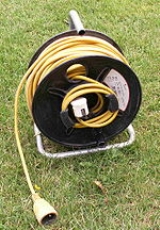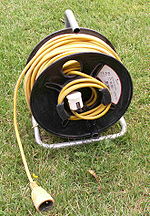
Reel
Encyclopedia

Construction
The size of the core is dependent on several factors. A smaller core will obviously allow more material to be stored in a given space. However, there is a limit to how tightly the stored material can be wound without damaging it and this limits how small the core can be.Other issues affecting the core size include:
- Mechanical strength of the core (especially with large reels)
- Acceptable turning speed (for a given rate of material moving on or off the reel a smaller core will mean that an almost empty reel has to turn faster)
- any functional requirements of the core e.g.
- For a reel that must be mechanically turned the size of the grips that mount it on the mechanical turning device.
- The size of the mountings needed to support the core during unwinding.
- Anything mounted on the cores (e.g. the sockets on an extension reel)
With material such as photographic film
Photographic film
Photographic film is a sheet of plastic coated with an emulsion containing light-sensitive silver halide salts with variable crystal sizes that determine the sensitivity, contrast and resolution of the film...
that is flat and long but is relatively wide, the material generally is stored in successive single layers. In cases where the material is more uniform in cross-section (for example, a cable), the material may be safely wound around a reel that is wider than its width. In this case, several windings are needed to create a layer on the reel.
Uses
Reel has potentially limitless uses, but major ones include:- A fishing reelFishing reelA fishing reel is a "cylindrical device attached to a fishing rod used in winding the line". Modern fishing reels usually have fittings which make it easier to retrieve the line and deploy it for better accuracy or distance. Fishing reels are traditionally used in the recreational sport of angling...
is used on a fishing rod to wind the fishingFishingFishing is the activity of trying to catch wild fish. Fish are normally caught in the wild. Techniques for catching fish include hand gathering, spearing, netting, angling and trapping....
line up. - Kite lines frequently are operated from reels.
- Specialized reels for holding tow line for hang glider, glider, and sailplane launching
- Laying of communications table use giant reels
- Winches wind cables on reels
- Webbing barriers that allow mobile post positions collect tensionally excess webbing.
- Tow trucks hold steel cable on reels.
- Garden hoses reeled solve hose kink problems.
- RopeRopeA rope is a length of fibres, twisted or braided together to improve strength for pulling and connecting. It has tensile strength but is too flexible to provide compressive strength...
, wireWireA wire is a single, usually cylindrical, flexible strand or rod of metal. Wires are used to bear mechanical loads and to carry electricity and telecommunications signals. Wire is commonly formed by drawing the metal through a hole in a die or draw plate. Standard sizes are determined by various...
and cableCableA cable is two or more wires running side by side and bonded, twisted or braided together to form a single assembly. In mechanics cables, otherwise known as wire ropes, are used for lifting, hauling and towing or conveying force through tension. In electrical engineering cables are used to carry...
is often supplied on reels. - Badge reels are used to hold badgeBadgeA badge is a device or fashion accessory, often containing the insignia of an organization, which is presented or displayed to indicate some feat of service, a special accomplishment, a symbol of authority granted by taking an oath , a sign of legitimate employment or student status, or as a simple...
s, ski passes and the like. - A cave divingCave divingCave diving is a type of technical diving in which specialized equipment is used to enable the exploration of caves which are at least partially filled with water. In the United Kingdom it is an extension of the more common sport of caving, and in the United States an extension of the more common...
reel is safety equipment used for running a guidelineDistance lineA distance line, penetration line or guideline is an item of diving equipment used by SCUBA divers as a means of returning to a safe starting point in conditions of low visibility, water currents or where pilotage is difficult...
.
Motion picture terminology
It is traditional to discuss the length of theatrical motion pictureFilm
A film, also called a movie or motion picture, is a series of still or moving images. It is produced by recording photographic images with cameras, or by creating images using animation techniques or visual effects...
s in terms of "reels." The standard length of a 35 mm motion picture reel is 1000 feet (304.8 m). This length runs approximately 11 minutes at sound speed (24 frames per second) and slightly longer at silent movie speed (which may vary from approximately 16 to 22 frames per second). Most films have visible cues which mark the end of the reel. This allows projectionists running reel-to-reel to change-over to the next reel on the other projector.
A so-called "two-reeler" would have run about 20–24 minutes since the actual short film shipped to a movie theater for exhibition may have had slightly less (but rarely more) than 1000 ft (about 305 m) on it. Most modern projectionists use the term "reel" when referring to a 2000 feet (609.6 m) "two-reeler," as modern films are rarely shipped by single 1000 feet (304.8 m) reels. A standard Hollywood movie averages about five 2000-foot reels in length.
The "reel" was established as a standard measurement because of considerations in printing motion picture film at a film laboratory, for shipping (especially the film case sizes) and for the size of the physical film magazine attached to the motion picture projector. Had it not been standardized (at 1000 feet (304.8 m) of 35 mm film) there would have been many difficulties in the manufacture of the related equipment. A 16 mm "reel" is 400 feet (121.9 m). It runs, at sound speed, approximately the same amount of time (11–12 minutes) as a 1000-foot 35 mm reel.
A split reel is a motion picture film reel in two halves that, when assembled, hold a specific length of motion picture film that has been wound on a plastic core. Using a split reel allows film to be shipped or handled in a lighter and smaller form than film would on a "fixed" reel. In silent film terminology, two films on one reel.
As digital cinema
Digital cinema
Digital cinema refers to the use of digital technology to distribute and project motion pictures. A movie can be distributed via hard drives, optical disks or satellite and projected using a digital projector instead of a conventional film projector...
catches on, the physical reel is being replaced by a virtual format called Digital Cinema Package
Digital Cinema Package
A Digital Cinema Package is a collection of digital files used to store and convey Digital cinema audio, image, and data streams.The term has been defined by Digital Cinema Initiatives, LLC in their recommendations for packaging of DC contents...
, which can be distributed using any storage media (such as hard drives) or data transfer medium (such as the Internet or satellite links) and projected using a digital projector instead of a conventional film projector
Film projector
Film projection or Film projector may refer to:*Movie projector for projection of moving images from film*Slide projector for projection of still images from film...
.
Demo reels
A demo reel, or show reel, is the motion picture or video equivalent of an artist's portfolio. It is typically used as a tool to promote the artist's skill, talent, and experience in a selected field, such as acting, directing, cinematography, editing, special effects, animation, or video games and other graphics. The demo reel is frequently submitted with a résuméRésumé
A résumé is a document used by individuals to present their background and skillsets. Résumés can be used for a variety of reasons but most often to secure new employment. A typical résumé contains a summary of relevant job experience and education...
to a prospective employer. When a reel contains scenes from actual productions, a shot list or credit list may also be submitted to describe the artist's specific involvement in each portion of the reel. While the usage of video excerpts on such showreels can be regarded as a breach of copyright, it is generally accepted in the film industry to do so, as it is the only tool of an artist to actually self-promote his/her work.

